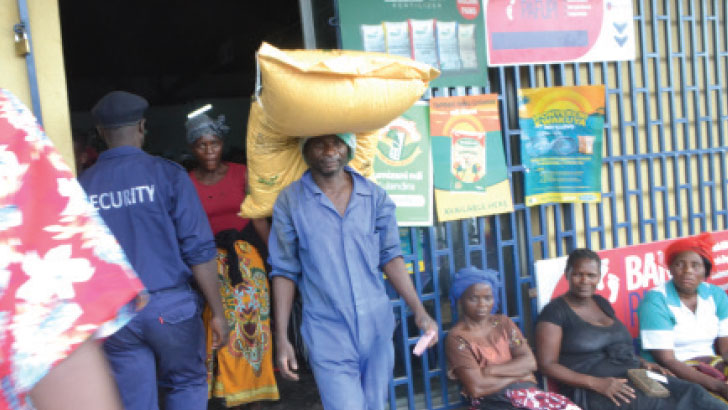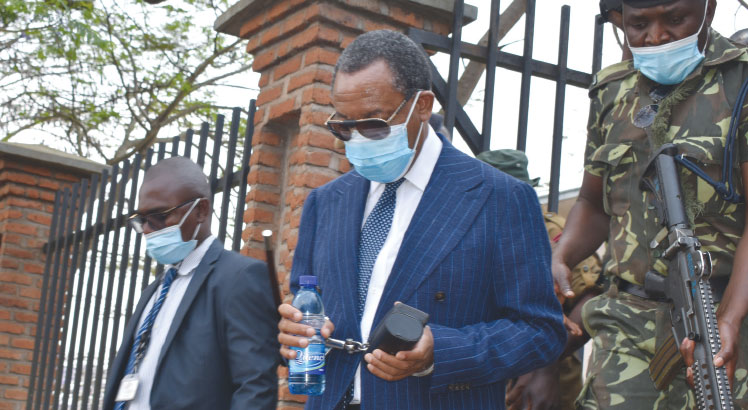With a 50 kilogramme bag now selling at an average of K49 000, the country sits on an AIP time bomb that would make poor farmers fail to redeem the commodity even after government contributed its K19 500 to the price.
This is the predicament that faces Rose Samisoni, a farmer from Dowa District, who under the current Affordable Inputs Programme (AIP) contributed only K7 500 to redeem a bag of fertiliser that cost about K27 000.
A Farmer carry a bag of fertiliser acquired under 2021/22 AIP
She fears the current hiked fertiliser prices, would see the group of 3.7 million smallholder farmers to whom she belongs sanctioned to pay around K30 000 or more per bag, something that is unaffordable for the target beneficiary group that survives on less than $1 per day.
Spot checks in agro-shops show that a fertiliser bag is selling at around K49 000, representing an increase of about 90 percent. The hike is being blamed on the rise in fuel prices and the war in Ukraine, provoked by the Russia invasion.
“If the [the redemption price] hit K30 000, I won’t manage. I am afraid my family will starve as we won’t harvest enough,” laments Samisoni, a single mother of three and a resident of Katsukunya Village, Traditional Authority Mkukula in Dowa.
Samisoni sells firewood to distillers of local spirit kachasu. She uses the earnings to meet her needs, including redeeming AIP fertiliser, which she confesses has made her family food secure over the past three years.
“I don’t make much from this firewood venture but, at least, it is something that keeps me going. Through the little savings I am able to buy subsidised fertiliser,” Samisoni, who is in her 40s, explained.
Currently the government has not signaled how it will handle the AIP conundrum in view of the rising fertiliser prices.
The prospects are not good as the Ministry of Finance and Economic Affairs (MFEA) has allocated K109 billion to AIP in the 2022/23 National Budget, which is K32 billion less than what was in the previous financial year.
Not much is set to change though as MFEA has vowed not to accommodate any changes to bloat the K2.84 trillion budget passed last month.
“As a country, we should learn to live within our means and stop bloating budgets whose sources said Minister of Finance Sosten Gwengwe after Parliament had just approved the 2022/23 budget.of funds are not clearly known,”
During the current farming season, government set the price of subsidised fertiliser at K27 000 per bag, with the Ministry of Agriculture covering K19 500 of the cost while farmers contributed K7 500.
And, as the government is scheming to reform AIP there are probably two outcomes; reducing the number of beneficiaries or increasing farmers monetary contribution or in the worst case scenario, adopt both.
Increasing the farmers’ contribution will mean government sustaining its K19 500 input and pushing the remainder to the farmers. In that case, if the suppliers maintain the K49 000 price or escalate it, the farmer will pay around K30 000 or more.
Meanwhile, agricultural policy think-tank Mwapata Institute executive director William Chadza has proposed that the AIP reforms should focus on trimming the number of beneficiaries and not stretching the farmers’ contribution.
He said: “The option of increasing the budget is already creating a very big fiscal burden. It is unlikely that there will be extra resources to increase the budget of the programme.
“We believe that if the number of beneficiaries is reviewed, perhaps we could get a reduction in terms of the numbers of those who are eligible. The other point to look at is the diversity in terms of the package.
“Focusing on maize alone and these inorganic fertilisers increases the fiscal burden but also looking at other promising value chains like legumes where support will largely be on seed as opposed to inorganic fertilisers.”
Chadza further argued that some beneficiaries are not reaping the rewards; hence, the need to enrol them to other social protection programmes.
He said: “There is also a need to look at how AIP can be looked at back-to-back with other programmes such as social protection, for example, because some of the beneficiaries under AIP now are not as productive and therefore not getting the best returns from the investments. More gains would be made if those were shifted to social protection initiatives.”
However, Stewart Kapiza, 35, from Kupenga Village in Traditional Authority Chimutu in Lilongwe District feels that trimming the number of beneficiaries may not be a good idea.
“This year I was struck off the list of beneficiaries for no apparent reason. I could not buy enough fertiliser off AIP and my crop fields are not looking promising. I don’t support that idea,” said the father of four, who sells pumpkins along the Kasungu-Lilongwe M1.
Ministry of Agriculture spokesperson Gracian Lungu in a written response on Wednesday said government was already in the process of reforming the AIP.
However, he could not provide details as to which options the government would lean on.
“Next AIP implementation will be announced anytime soon. We are currently working out on a reform paper and once it is adopted by the Cabinet, we will notify the general public on how we are to approach this year’s programme,” he said.
But if government maintains 7.4 million beneficiaries and allow them to redeem a bag of fertiliser at K7 500, then it will need K307 billion which is thrice the AIP allocation in the national budget.
However, government has allocated only K109 billion to AIP in the 2022/23 national budget.
The World Bank assessment of Malawi which was updated on its website on April 7 2022, says the country was facing economic pressure from the Covid-19 pandemic and government expansionary policies, including the AIP.
“Despite record harvests, food insecurity continues to be at a high level. The number of Malawians facing high-level acute food insecurity decreased from an estimated 1.7 million in September 2020 to a still high 1.1 million.
“The national poverty rate has slightly declined from 51.5 percent in 2015/16 to 50.7 percent in 2019/20. Poverty in Malawi is driven by low productivity in the agriculture sector, limited opportunities in non-farm activities, volatile economic growth, rapid population growth, and limited coverage of safety net programmes and targeting challenges,” reads the overview in part on www.worldbank.org.
The post Small-scale farmers panic as fertiliser prices rise appeared first on The Nation Online.
 Moni Malawi
Moni Malawi 

